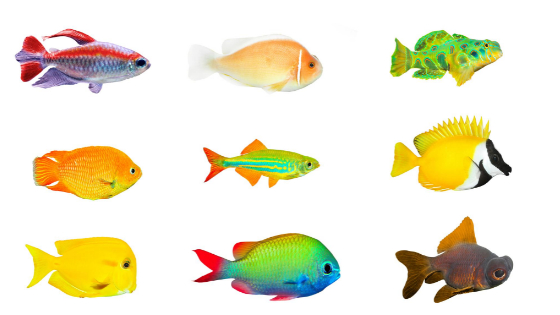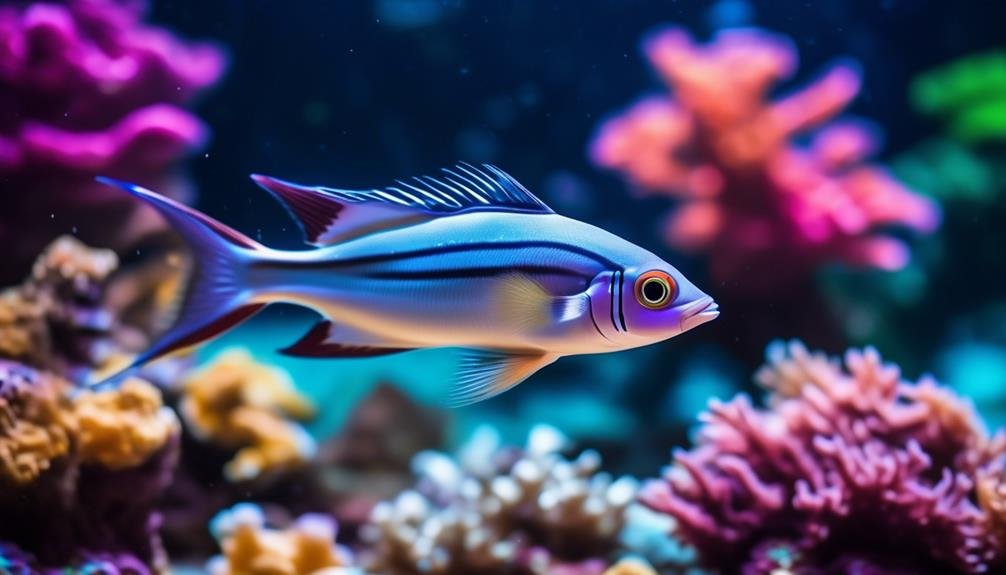
Looking to enhance your marine aquarium with a captivating and resilient addition? Look no further than the dartfish! This remarkable marine species, known for its intelligence and adaptability, is a true marvel. With its small size and peaceful nature, the dartfish is a perfect fit for any saltwater community.
But that’s not all – there’s much more to discover about the fascinating world of dartfish. So, let’s dive in and uncover the secrets of this hardy, intelligent marvel of marine aquariums.
Key Takeaways
- Dartfish are small-sized saltwater fish that are hardy and easy to care for, making them suitable for beginners.
- They prefer medium-sized tanks of at least 30 gallons and are most comfortable in the middle swimming region of the tank.
- Dartfish thrive in clean and stable water conditions, requiring regular water changes and proper filtration.
- They are highly intelligent and can recognize their owners, making them interactive and fascinating to observe in the aquarium.
Dartfish Overview
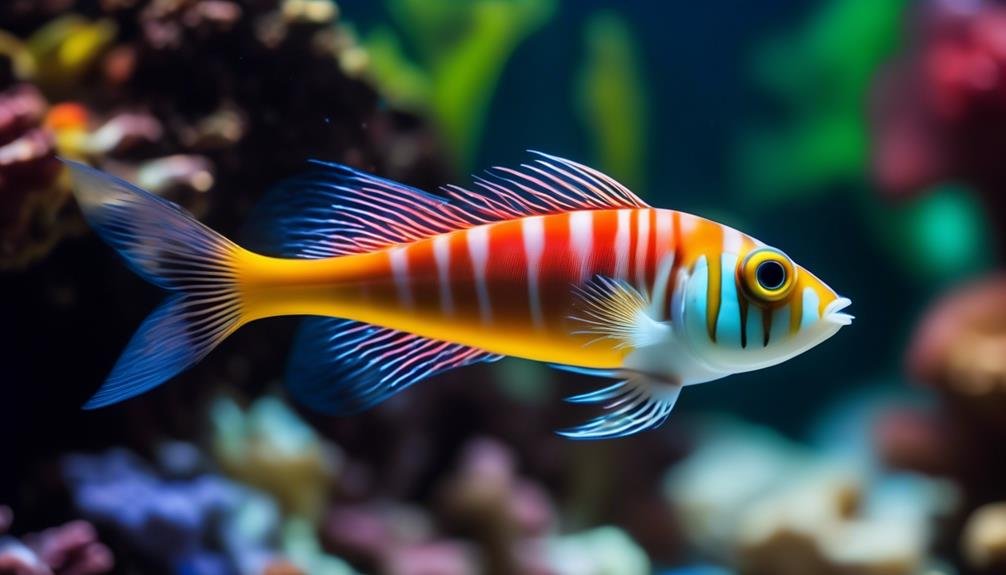
Dartfish, a small-sized saltwater group known for their non-aggressive temperament, are a staple in the marine aquarium hobby. These fascinating creatures are perfect for beginners and novice aquarists due to their hardy nature and easy care requirements.
With their vibrant colors and unique patterns, Dartfish add beauty and charm to any aquarium setup. They prefer a medium-sized tank of at least 30 gallons and are most comfortable in the middle swimming region.
Dartfish are highly intelligent and require a varied diet of live and frozen foods to thrive. They happily accept flake-based foods, including brine shrimp, mysis shrimp, and krill.
With proper nutrition and weekly care, Dartfish will flourish in your aquarium and bring joy to your underwater world.
Tank Requirements for Dartfish
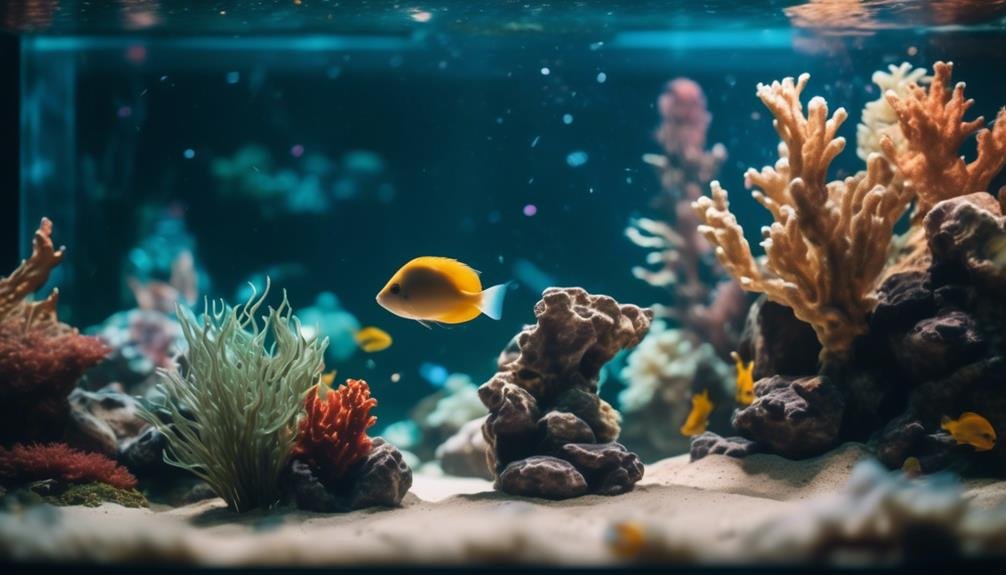
To ensure the optimal habitat for Dartfish, it’s important to meet their specific tank requirements. Here are four key factors to consider:
- Tank size: Dartfish thrive in medium-sized aquariums, with a minimum capacity of 30 gallons. This provides them with enough space to swim freely and explore their environment.
- Swimming region: Dartfish prefer the middle region of the tank, so it’s essential to provide plenty of open space in this area for their swimming activities.
- Tank mates: When choosing tank mates for Dartfish, opt for peaceful species such as Anthias, Blennies, Clownfish, Gobies, and Hawkfish. These companions will create a harmonious environment for the Dartfish.
- Water quality: Maintaining a clean and stable environment is crucial for the well-being of Dartfish. Regular water changes and proper filtration are necessary to ensure optimal water parameters.
Compatible Tank Mates for Dartfish

When considering tank mates for your Dartfish, it’s important to choose peaceful species that will create a harmonious environment. Dartfish are small, non-aggressive fish that thrive in a medium-sized saltwater aquarium.
Some suitable tank mates for Dartfish include Anthias, Blennies, Clownfish, Gobies, and Hawkfish. These species share similar temperaments and swimming regions, making them compatible companions for Dartfish.
It’s crucial to provide proper care for your Dartfish and their tank mates. Weekly maintenance is necessary, but Dartfish are hardy and suitable for beginner aquarists. Their highly intelligent nature makes them a staple in the marine aquarium hobby.
When it comes to feeding, Dartfish have a carnivorous diet and thrive on a varied menu of live and frozen foods.
Care Level and Intelligence of Dartfish
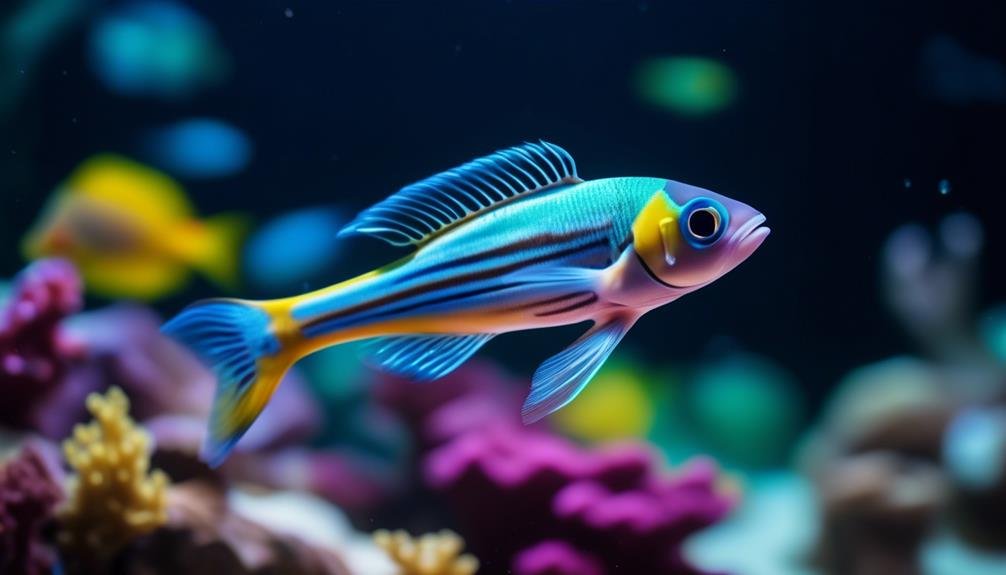
Caring for Dartfish is a rewarding experience due to their high intelligence and manageable care level. Here are four reasons why they make an excellent addition to your marine aquarium:
- Low maintenance: Dartfish are hardy species that can adapt to a variety of water conditions. They require weekly care and are suitable for beginner and novice aquarists.
- Highly intelligent: Dartfish are known for their intelligence and problem-solving abilities. They can learn to recognize their owners and interact with them, making them fascinating to observe.
- Peaceful tank mates: Dartfish have a non-aggressive temperament, making them compatible with a wide range of tank mates such as anthias, blennies, clownfish, gobies, and hawkfish.
- Varied diet: Dartfish are carnivorous and thrive on a varied diet of live and frozen foods. They readily accept flake-based foods and enjoy brine shrimp, mysis shrimp, and krill.
With their intelligence and easy care requirements, Dartfish are a staple in the marine aquarium hobby and a joy to care for.
Feeding Habits of Dartfish
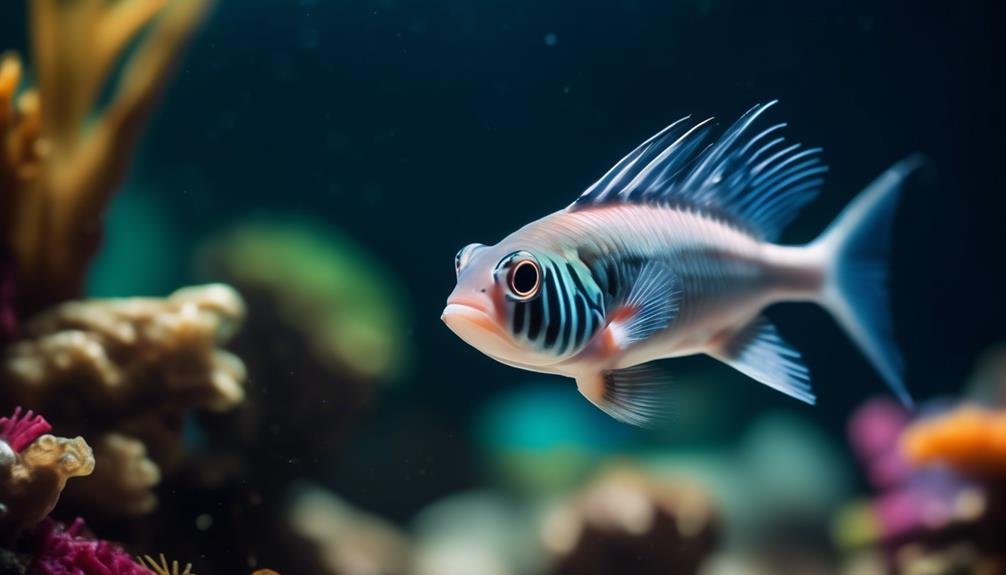
Dartfish’s carnivorous nature and varied diet make their feeding habits a crucial aspect of their care. These small-sized saltwater fish thrive with proper nutrition. They’ve a carnivorous diet consisting of live and frozen foods. Dartfish readily accept flake-based foods, making it easier for aquarists to provide a balanced diet.
Their food options include brine shrimp, mysis shrimp, and krill. Feeding them a varied diet is important to ensure they receive all the necessary nutrients. By offering a diverse range of food, you can mimic their natural feeding behavior in the wild.
Providing regular feedings and monitoring their intake will help maintain their health and vitality. Remember to adjust the feeding quantities based on their appetite and the size of the tank.
Providing Proper Nutrition for Dartfish
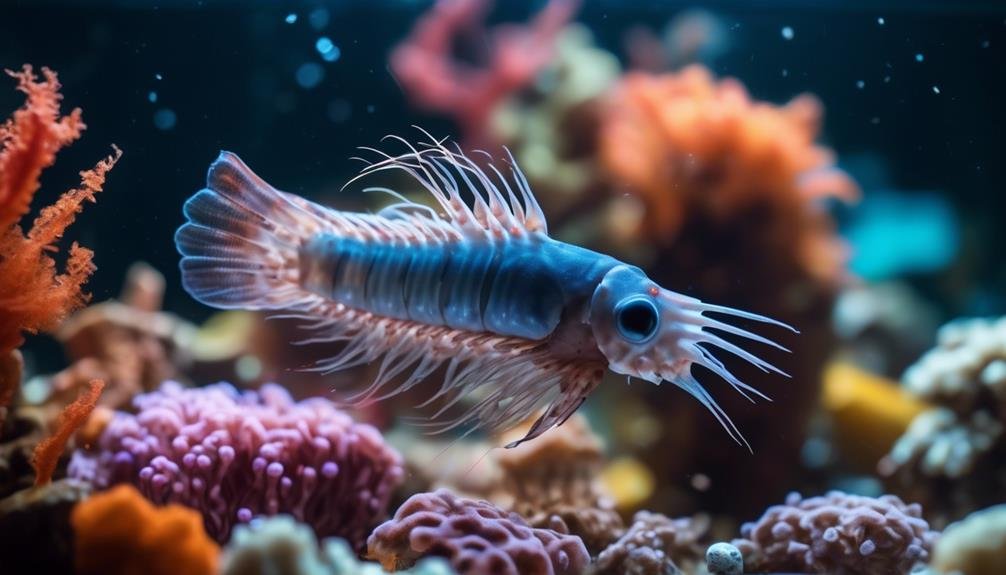
To ensure the health and vitality of your Dartfish, it’s essential to provide them with proper nutrition. Here are four key points to keep in mind when feeding your Dartfish:
- Carnivorous diet: Dartfish are carnivores, so it’s important to feed them a diet that consists mainly of live and frozen foods. This can include brine shrimp, mysis shrimp, and krill.
- Varied diet: Offering a variety of foods is crucial to ensure that your Dartfish receives all the necessary nutrients. Try to incorporate different types of live and frozen foods into their diet to keep them healthy and satisfied.
- Acceptance of flake-based foods: Although Dartfish prefer live and frozen foods, they can also accept flake-based foods. It’s a good idea to offer them a mix of both to provide a balanced diet.
- Thriving with proper nutrition: Providing your Dartfish with proper nutrition won’t only keep them healthy, but it will also help them thrive in your marine aquarium. By offering a varied and balanced diet, you can promote their overall well-being and longevity.
Breeding Behavior of Dartfish
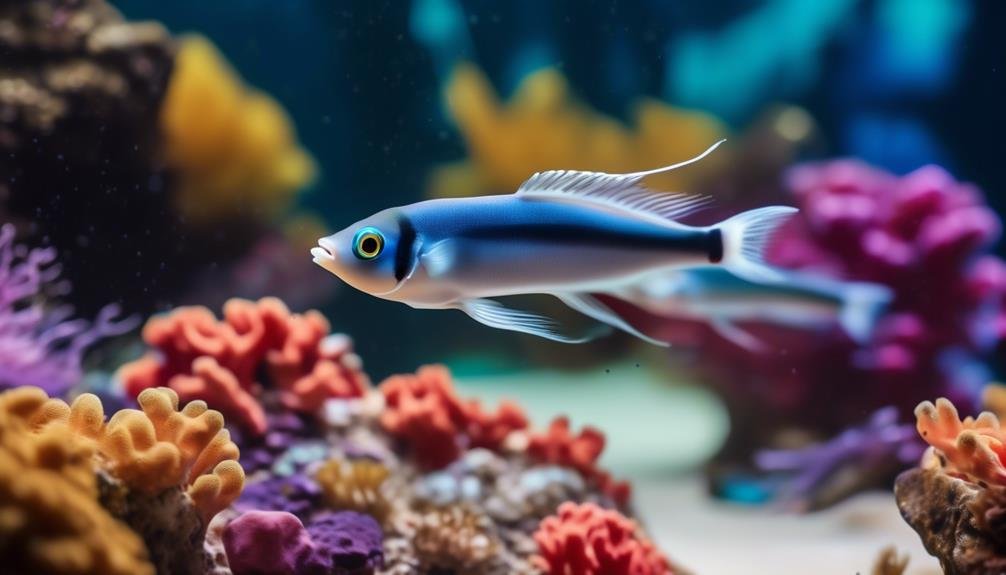
When it comes to the breeding behavior of Dartfish, their unique reproductive habits and parental instincts make them a fascinating species to observe in marine aquariums.
Dartfish are egg-laying, parental species that care for their spawns. The spawning process typically occurs in caves and crevices of aquarium setups, providing a safe environment for the eggs. However, there’s limited information available on raising the fry, making it a challenging endeavor for aquarists.
Despite this, the breeding behavior of Dartfish has been observed in captivity, offering valuable insights into their reproductive biology. Witnessing the dedication and care exhibited by Dartfish parents as they protect and nurture their young is truly a remarkable sight in the world of marine aquariums.
Parental Care in Dartfish
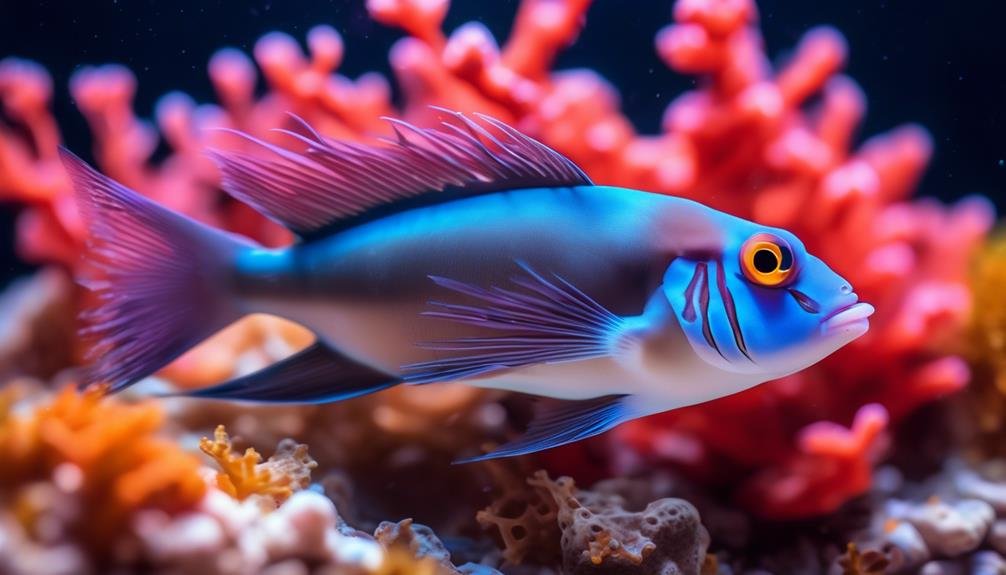
The remarkable dedication and care exhibited by Dartfish parents as they protect and nurture their young is a captivating display of parental instincts in the marine aquarium world. Here are some key aspects of parental care in Dartfish:
- Spawning: Dartfish are egg-laying species that spawn in caves and crevices of aquarium setups. They carefully choose these locations to provide a safe and secluded environment for their offspring.
- Egg protection: Once the eggs are laid, the parents diligently guard and protect them from potential threats. They fan the eggs with their pectoral fins to ensure proper oxygenation and prevent any harmful buildup of debris.
- Fry care: After hatching, the parents continue to show unwavering care for their fry. They actively hunt for small food particles and bring them back to the fry, ensuring their nourishment and growth.
- Family bond: Dartfish parents form a strong bond with their offspring, often staying close to them and guiding them through their early stages of life. This close-knit family dynamic is a testament to the exceptional parenting skills of Dartfish.
Spawning Habits of Dartfish
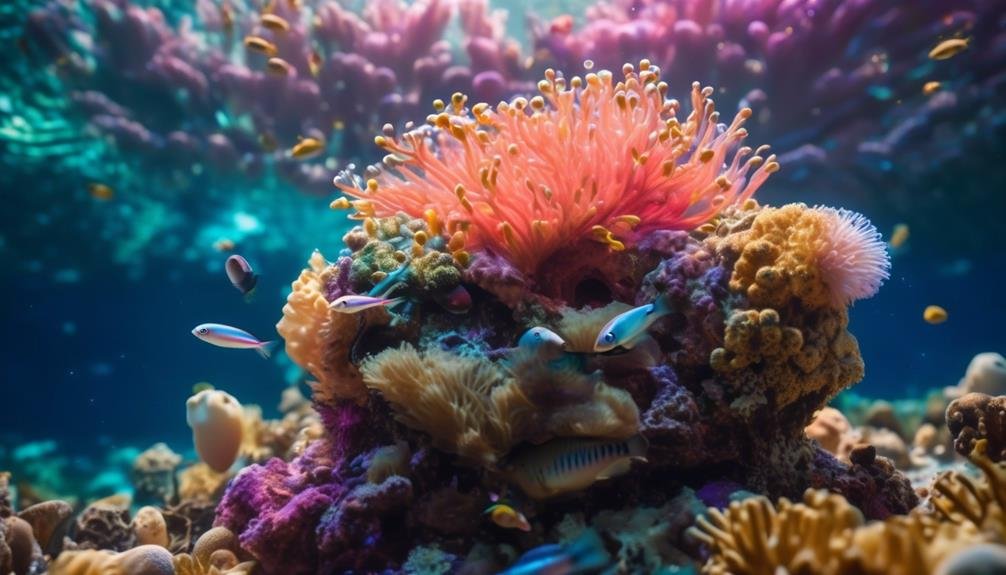
Dartfish display fascinating spawning habits, choosing carefully hidden caves and crevices within their aquarium setups to lay their eggs. These small, saltwater fish are known for their parental care and will diligently guard their spawns.
However, there’s limited information on raising the fry in captivity.
When it comes to breeding behavior, dartfish have been observed spawning in the safety of their chosen hiding spots. Their preference for caves and crevices ensures the protection of their eggs from potential predators. This behavior showcases their intelligence and adaptability in creating a safe environment for their offspring.
With their unique spawning habits, dartfish continue to captivate and amaze marine aquarium enthusiasts worldwide.
Raising Fry in Dartfish
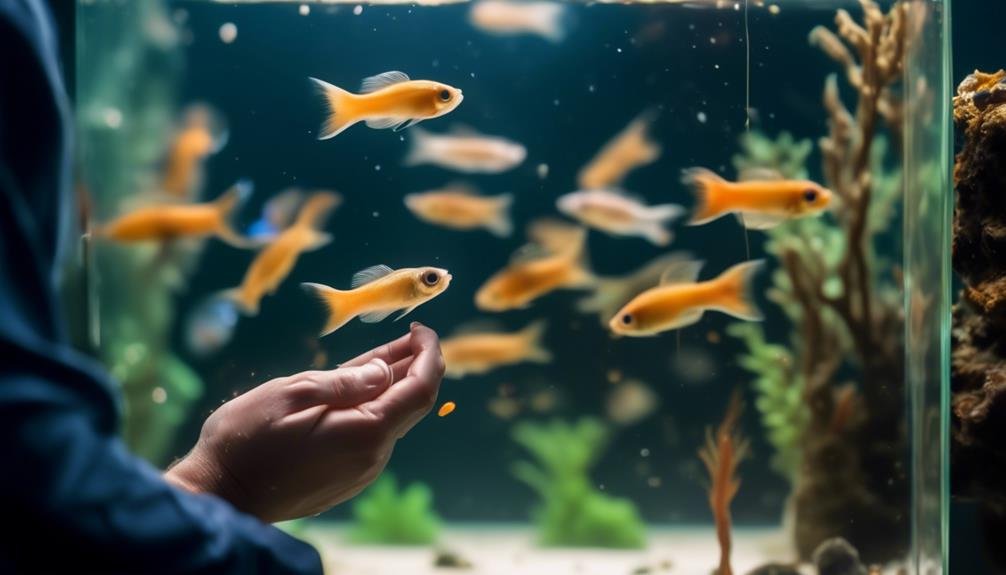
After observing the fascinating spawning habits of dartfish, it’s now time to explore the process of raising their fry.
Here are four important steps to consider when raising dartfish fry:
- Provide a separate nursery tank: Set up a small tank with appropriate water parameters and a gentle filtration system. This will ensure a safe and controlled environment for the fry to grow.
- Feed them small, frequent meals: Dartfish fry have tiny mouths, so it’s crucial to offer them appropriately sized food. Provide a varied diet of freshly hatched brine shrimp, copepods, and finely crushed flake food multiple times a day.
- Maintain excellent water quality: Regular water changes and careful monitoring of ammonia, nitrite, and nitrate levels are essential for the fry’s health. Keep the temperature stable and provide adequate filtration.
- Gradually introduce them to the main tank: Once the fry have reached a suitable size and are robust enough, slowly acclimate them to the main tank. Monitor their behavior closely and ensure they can safely navigate the larger environment.
Observations of Dartfish Breeding in Captivity
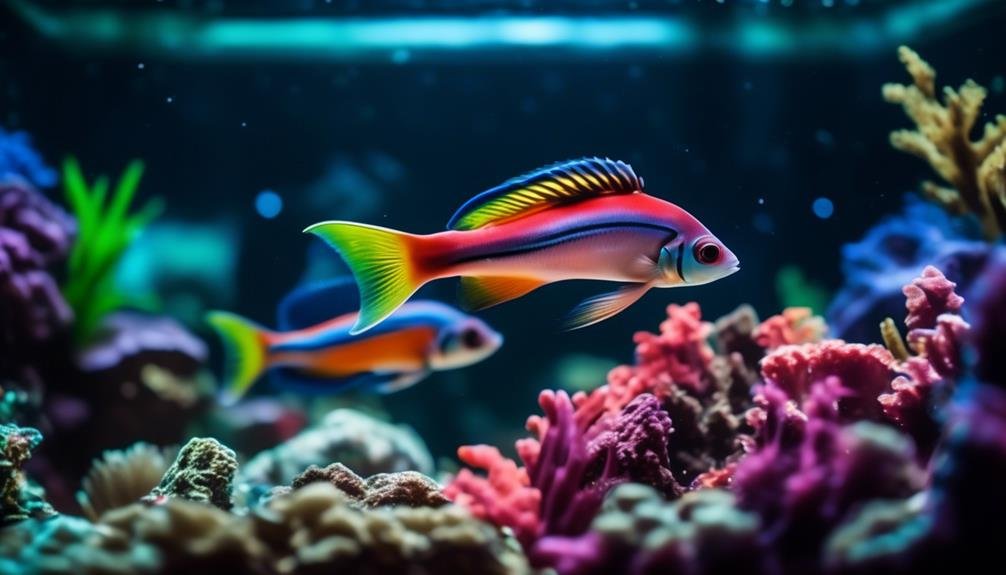
One fascinating aspect of breeding dartfish in captivity is the opportunity to observe their unique reproductive behaviors. These small, saltwater fish are known for their non-aggressive temperament and medium-sized aquarium requirements. When it comes to breeding, dartfish are egg-laying, parental species that care for their spawns. They often choose to spawn in caves and crevices of aquarium setups, providing a safe environment for their eggs. However, there is limited information available on raising the fry. Despite this, many aquarists have reported observing interesting breeding behaviors in their captive dartfish. By providing the right conditions and closely monitoring their behavior, you may have the chance to witness the intricate courtship rituals and nurturing instincts of these intelligent marvels of the marine aquarium world.
| Unique Reproductive Behaviors |
|---|
| Egg-laying, parental species |
| Choose to spawn in caves and crevices |
| Limited information on raising the fry |
Weekly Care Routine for Dartfish
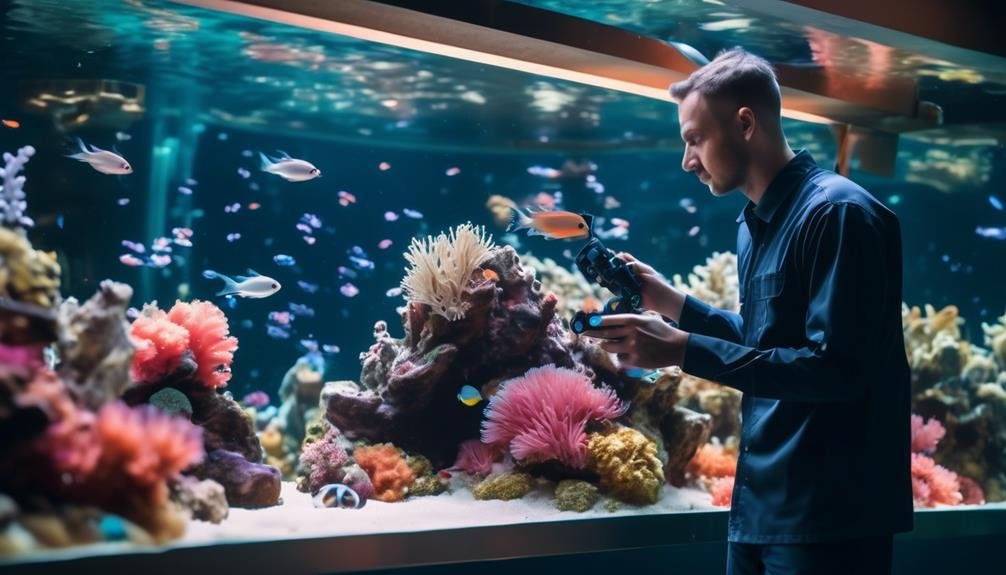
To ensure the health and well-being of your dartfish, it’s important to establish a weekly care routine. Here are four key steps to follow:
- Water Quality Maintenance:
- Regularly test the water parameters such as temperature, pH, ammonia, and nitrate levels.
- Perform partial water changes of 10-20% to maintain optimal water quality.
- Feeding Schedule:
- Dartfish are carnivorous and require a varied diet.
- Offer a mix of live and frozen foods like brine shrimp, mysis shrimp, and krill.
- Supplement with high-quality flake foods to ensure proper nutrition.
- Tank Cleaning:
- Clean the aquarium glass, decorations, and filtration system to remove algae and debris.
- Use a gravel vacuum to remove any waste from the substrate.
- Observation and Interaction:
- Spend time observing your dartfish to ensure they’re behaving normally.
- Interact with them by offering food and engaging in gentle tank maintenance.
- Building a bond with your dartfish will enhance their overall well-being.
Tips for Keeping Dartfish Healthy

To ensure the ongoing health and well-being of your dartfish, it’s essential to follow these tips for maintaining their optimal condition.
Firstly, provide a suitable tank environment. Dartfish thrive in a medium-sized aquarium of at least 30 gallons, with plenty of hiding spots and open swimming space in the middle region.
Secondly, choose compatible tank mates such as anthias, blennies, clownfish, gobies, and hawkfish. These species have non-aggressive temperaments and can coexist peacefully with dartfish.
Next, provide a varied and carnivorous diet for your dartfish. Offer a combination of live and frozen foods like brine shrimp, mysis shrimp, and krill. Dartfish also accept flake-based foods.
Lastly, maintain a weekly care routine for your dartfish, as they require regular attention and care.
Conclusion: Dartfish as a Marvel in Marine Aquariums
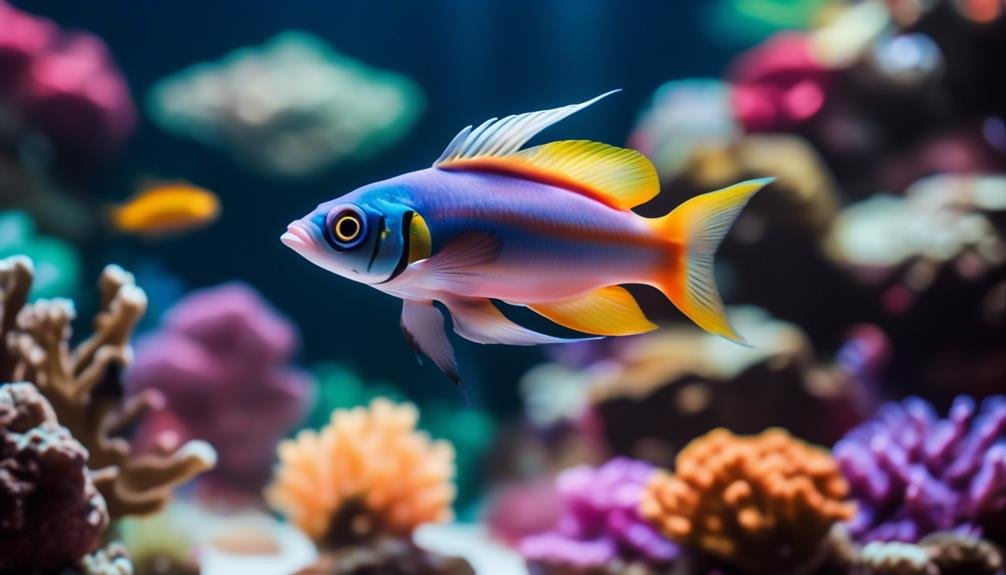
Dartfish truly stand out as a marvel in marine aquariums. These small saltwater creatures possess a non-aggressive temperament, making them suitable tank mates for anthias, blennies, clownfish, gobies, and hawkfish. With their hardy nature and medium-sized aquarium needs, they’re perfect for beginner and novice aquarists.
Their high intelligence is a staple in the marine aquarium hobby, making them a fascinating addition to any tank. Weekly care is required for these carnivorous fish, but they readily accept a varied diet of live and frozen foods, as well as flake-based options.
Breeding behavior has been observed in captivity, adding another intriguing aspect to their marvel. Dartfish truly bring wonder and beauty to marine aquariums.
Frequently Asked Questions
How Long Do Dartfish Typically Live in Captivity?
Dartfish typically live for about 3 to 5 years in captivity. They are hardy and intelligent marine aquarium fish known for their beautiful colors and peaceful nature.
Are Dartfish Prone to Any Specific Diseases or Health Issues?
Dartfish are generally hardy and not prone to specific diseases or health issues. However, it’s important to maintain a clean and stable environment, provide proper nutrition, and monitor water parameters to ensure their well-being.
Can Dartfish Be Kept With Other Aggressive Fish Species?
No, dartfish cannot be kept with other aggressive fish species. Their non-aggressive temperament makes them suitable for tank mates like anthias, blennies, clownfish, gobies, and hawkfish.
Do Dartfish Require Any Special Lighting or Water Conditions?
Dartfish don’t require special lighting, but they prefer moderate to high intensity. For water conditions, they need stable salinity and pH levels, along with good water quality. Regular testing and maintenance are important.
Are Dartfish Suitable for Reef Tank Setups?
Yes, dartfish are suitable for reef tank setups. They are non-aggressive and can coexist with a variety of tank mates. Their small size and medium-sized aquarium needs make them a great addition to a reef tank.
How Do Dartfish Compare to Frogfish in Terms of Adaptability in Marine Aquariums?
Dartfish and frogfish both exhibit unique adaptability in marine aquariums. While dartfish are known for their vibrant colors and shoaling behavior, mysterious frogfish masters camouflage techniques to blend seamlessly into their surroundings. Both species bring their own charm and beauty to underwater environments, captivating aquarium enthusiasts worldwide.
Conclusion
In conclusion, adding a dartfish to your marine aquarium is a fantastic choice. With their small size, non-aggressive temperament, and intelligence, dartfish are a vibrant and captivating addition to any saltwater group.
They get along well with a variety of tank mates and have a hardy nature, making them suitable for beginners. Their carnivorous diet is easy to meet, and while breeding in captivity has been observed, more information is needed.
Overall, dartfish are a marvelous and fascinating species that will thrive in your marine aquarium.




